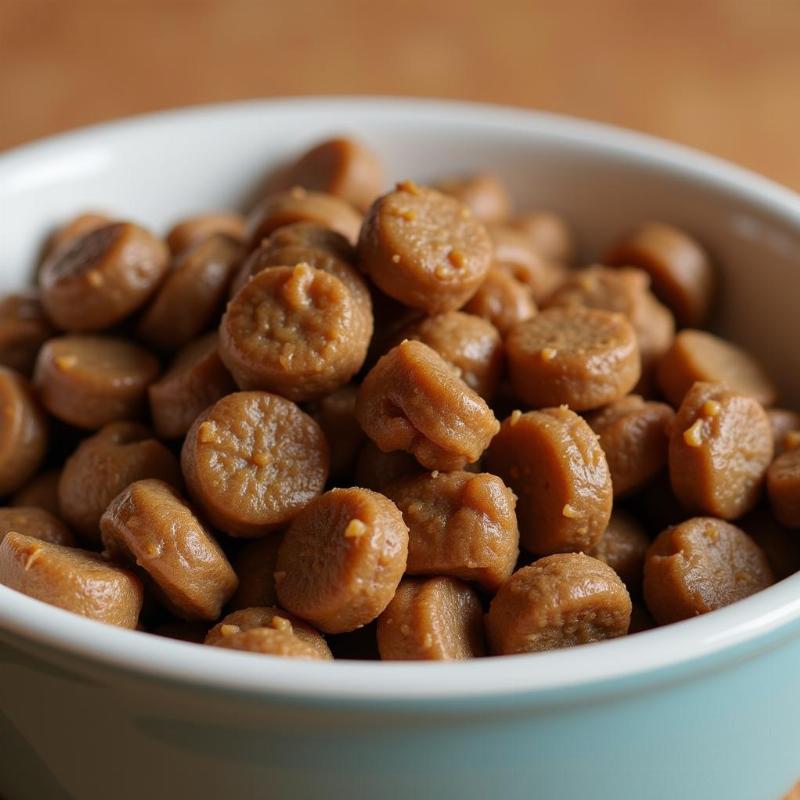Losing teeth is a common occurrence in older dogs, and it can significantly impact their ability to eat. Choosing the best dog food for a toothless dog requires careful consideration of texture, nutritional value, and palatability. This guide will explore the options available and help you make the right choice for your senior companion.
Understanding Your Toothless Dog’s Dietary Needs
 Dog food for dogs with no teeth
Dog food for dogs with no teeth
Just because a dog has lost its teeth doesn’t mean its nutritional needs change drastically. They still require a balanced diet rich in protein, healthy fats, carbohydrates, vitamins, and minerals. However, the form in which they receive these nutrients becomes crucial. Senior dogs also often have other health concerns that should be considered when choosing their food. For example, joint support with glucosamine and chondroitin may be beneficial.
Types of Dog Food for Toothless Dogs
Several types of dog food are suitable for dogs without teeth. The key is to find something easily digestible and doesn’t require chewing. Let’s examine the most popular options available in the US market.
Wet Canned Food
Wet canned food is an excellent choice for dogs with no teeth. Its soft, moist texture makes it easy to lap up and swallow. Many brands offer pate-style food, which is particularly suitable for toothless dogs. Look for options that are specifically formulated for senior dogs, as these often contain added nutrients to support aging joints and other common senior health concerns.
Soft Dry Food
Some dry kibble brands are designed to soften quickly when mixed with water or broth. This creates a mushy consistency that is easy for toothless dogs to consume. This option can be more cost-effective than canned food but ensure the kibble softens sufficiently to prevent choking hazards.
Homemade Food
If you prefer to have complete control over your dog’s diet, preparing homemade food is a viable option. You can create nutritious and palatable meals by blending ingredients like cooked meat, vegetables, and rice into a smooth puree. However, consulting with a veterinary nutritionist is essential to ensure the diet meets all your dog’s nutritional requirements. Remember to avoid toxic ingredients for dogs, such as onions, grapes, and chocolate.
Raw Food Diets
While raw food diets have gained popularity, they pose certain risks, particularly for senior dogs with compromised immune systems. If considering a raw diet, be sure to discuss it thoroughly with your veterinarian. Ensure the ingredients are human-grade and handled with strict hygiene to minimize bacterial contamination.
Choosing the Right Food: Factors to Consider
Choosing the best dog food for your toothless dog requires considering several factors:
- Nutritional Completeness: Ensure the food meets the Association of American Feed Control Officials (AAFCO) standards for complete and balanced nutrition for senior dogs.
- Ingredients: Opt for high-quality ingredients, with real meat or poultry as the primary protein source. Avoid artificial colors, flavors, and preservatives.
- Calorie Density: Senior dogs often have lower energy requirements. Choose a food with an appropriate calorie density to maintain a healthy weight.
- Palatability: Encourage your dog’s appetite by choosing a food that smells and tastes appealing. Experiment with different flavors and textures to find what your dog enjoys most.
Tips for Feeding a Toothless Dog
- Warm the food slightly: Warming the food can enhance its aroma and make it more enticing for your dog.
- Serve small, frequent meals: This can be easier for a toothless dog to digest than one or two large meals.
- Elevate the food bowl: Raising the food bowl can make it more comfortable for your dog to eat.
- Monitor your dog’s weight: Regular weight checks are essential to ensure your dog is maintaining a healthy weight.
Conclusion
Finding the best dog food for dogs with no teeth requires understanding their unique needs. Prioritize soft, easily digestible options, and ensure the food provides complete and balanced nutrition. By following these guidelines, you can help your toothless companion enjoy mealtimes and maintain optimal health.
FAQ
- Can a dog live without teeth? Yes, dogs can adapt surprisingly well to life without teeth.
- What is the easiest food for a dog to eat without teeth? Wet canned food or softened dry kibble are generally the easiest options.
- Do I need to supplement my dog’s diet if they have no teeth? Discuss any necessary supplements with your veterinarian based on your dog’s individual needs.
- How often should I feed my toothless dog? Smaller, more frequent meals are often recommended.
- What should I do if my toothless dog is losing weight? Consult with your veterinarian to rule out any underlying medical conditions and adjust their diet if needed.
- Can I give my toothless dog bones? Avoid giving bones to toothless dogs as they can pose a choking hazard.
- Are dental chews safe for dogs with no teeth? Dental chews are not suitable for toothless dogs.
Beautdogs.us is your premier resource for all things dog-related in the United States. We offer expert advice on dog breeds, care, and product recommendations. Whether you’re a new dog owner or a seasoned expert, Beautdogs.us provides trustworthy information to help you navigate the world of dog ownership. Contact us today for all your dog-related inquiries! Email: [email protected], Phone: +1 501-555-7529. Let Beautdogs.us help you provide the best care for your canine companion.